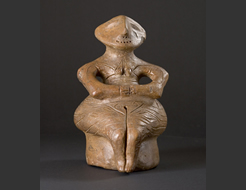|
||||||||||||||||||||||||||||||||
|
|
Museum of: Wien | |||||||||||||||||||||||||||||||
| Name of the artefact: Female figurine from Pazardzik | ||||||||||||||||||||||||||||||||
|
Female figurine seated on a chair ot throne. Incised
decorations on a naked body probably representing tattoes. the incisions
include spiralic endings an rhombus. The figurine was often regarded as an
early representation of a fertility goddess. |
||||||||||||||||||||||||||||||||
|
WHERE IS IT AND MAIN
CHARACTERISTICS |
STATE |
|||||||||||||||||||||||||||||||
|
Department: |
Prehistory |
Preservation: |
Very good | |||||||||||||||||||||||||||||
|
Inventory number: |
20.461 |
Restauration: |
Restored | |||||||||||||||||||||||||||||
|
Name of the artefact: |
Female figurine from
Pazardzik |
Completeness: |
Complete | |||||||||||||||||||||||||||||
|
Object type: |
Human figurine |
|||||||||||||||||||||||||||||||
|
Material: |
Ceramic |
|||||||||||||||||||||||||||||||
|
Methof of manufacture: |
Burnt clay |
|||||||||||||||||||||||||||||||
|
Decoration
type: |
No decoration |
|||||||||||||||||||||||||||||||
|
Distinctive mark: |
- |
|||||||||||||||||||||||||||||||
|
DIMENSIONS |
PERIOD OF USE |
|||||||||||||||||||||||||||||||
|
Length (mm): |
19cm |
Epoque: |
Neolithic |
|||||||||||||||||||||||||||||
|
Heigth
(mm): |
- |
Culture: |
- |
|||||||||||||||||||||||||||||
|
Diameter
(mm): |
- |
Period: |
Middle neolithic |
|||||||||||||||||||||||||||||
|
Width (mm): |
- |
Face: |
- |
|||||||||||||||||||||||||||||
|
Thickness (mm): |
- |
Absolute chronology: |
4500 bc |
|||||||||||||||||||||||||||||
|
Weight
(g): |
- |
|||||||||||||||||||||||||||||||
DISCOVERY |
||||||||||||||||||||||||||||||||
|
Date: |
1877 |
Country: |
Bulgaria |
|||||||||||||||||||||||||||||
|
District: |
- |
Town hall affiliation: |
- |
|||||||||||||||||||||||||||||
|
Village: |
Pazardzik |
Discovery findspot: |
Maritza valley |
|||||||||||||||||||||||||||||
|
Condition of discovery: |
Chance Discovery |
Discovery type: |
Deposit |
|||||||||||||||||||||||||||||
|
ANALYSES – DETERMINATIONS |
FILLED IN BY |
|||||||||||||||||||||||||||||||
|
Type: |
- |
Name: |
Walpurga Antl |
|||||||||||||||||||||||||||||
|
Laboratory: |
- |
Institution: |
Natural History Museum Vienna |
|||||||||||||||||||||||||||||
|
No./Code: |
- |
Date: |
20/02/2006 |
|||||||||||||||||||||||||||||
|
DEEPENINGS |
||||||||||||||||||||||||||||||||
|
Morphology of the object: |
||||||||||||||||||||||||||||||||
|
The naked figurine has a flat stylized face and is
sitting on a round chair or throne. |
||||||||||||||||||||||||||||||||
|
Decoration: |
||||||||||||||||||||||||||||||||
|
Incised spirals and rhombus. |
||||||||||||||||||||||||||||||||
|
Inscription: |
||||||||||||||||||||||||||||||||
|
- |
||||||||||||||||||||||||||||||||
|
Analogies: |
||||||||||||||||||||||||||||||||
|
The pictograms can be compared to those on the spoon
from Wetzleinsdorf. She is contemporeanous to Painted Pottery settlements
in the East of Austria. |
||||||||||||||||||||||||||||||||
|
Interpretation: |
||||||||||||||||||||||||||||||||
|
The figurine as well as similar figurines is thought to
have been used in rituals. She is seen as an early representation of a
fertility goddess. The incised decoration is interpreted as tattoo.
Because of the stylized representation of sex characteristics we can
exclude that the incised decoration represent clothes. |
||||||||||||||||||||||||||||||||
|
Bibliography: |
||||||||||||||||||||||||||||||||
|
TODOROWA, H. (1982): Das Äneolithikum in Bulgarien. In:
Jungsteinzeit in Bulgarien, Wolfenbüttel, 25-29. ANGELI, W. (1976):
Kupferzeitliche Idole aus Thrakien in der Prähistorischen Sammlung. Ann.
D. Naturhist. Mus. 80, 815-818 |
||||||||||||||||||||||||||||||||

